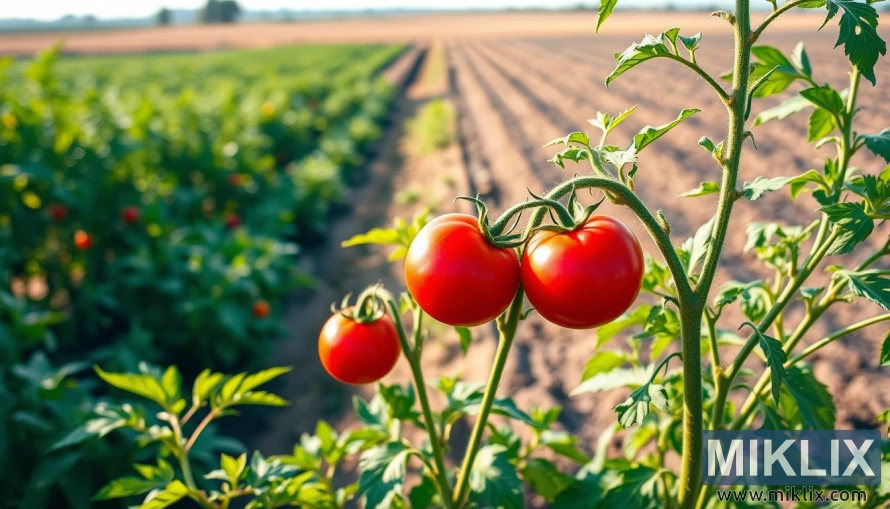Image: Organic vs Conventional Tomatoes
Published: March 26, 2025 at 6:25:49 PM UTC
Last updated: September 23, 2025 at 9:20:01 PM UTC
Lush organic tomato plant with vibrant red fruit contrasts with dull conventional farming, highlighting vitality, abundance, and nutritional differences.
In this evocative image, the contrast between organic vitality and conventional sterility is captured through the humble yet powerful lens of the tomato plant. In the foreground, a thriving organic tomato plant rises proudly, its stalks strong and verdant, leaves broad and textured with a deep emerald sheen that speaks to their health. Nestled among the foliage are clusters of ripening fruit, their glossy red skins shimmering under the caress of warm, natural sunlight. The tomatoes hang heavily on the vine, plump and firm, their color a rich, inviting crimson that symbolizes ripeness, nourishment, and the culmination of careful, sustainable cultivation. These fruits appear almost to glow with life, embodying the essence of what fresh, organically grown produce should be—untouched by chemicals, nurtured by the soil, sun, and rain, and full of both visual and nutritional vibrancy.
As the eye moves toward the middle ground, the scene begins to shift in tone. Here, a smaller tomato plant represents a more conventional method of farming, and its appearance tells a very different story. The leaves seem slightly paler, their edges curling, and the fruit, while still red, lacks the same intensity of color and sheen. They appear smaller, less robust, and somehow diminished when compared to the rich bounty of their organic counterparts. The juxtaposition is subtle but unmistakable, offering a quiet commentary on how farming practices can shape not only the look and taste of produce but also the vitality they convey. The conventional plant seems to stand in shadow, while the organic plant bathes in light, heightening the sense of contrast and further emphasizing the divide between these two worlds of agriculture.
The background intensifies this narrative, drawing the viewer deeper into the broader context of farming practices. To one side, the organic field stretches lush and abundant, rows of thriving green plants rolling gently into the horizon, each alive with promise and productivity. The foliage here is dense and textured, suggesting a landscape teeming with biodiversity and ecological balance. To the other side, however, lies the stark emptiness of conventional farming: dry, barren furrows cut into the earth, their lifeless soil exposed beneath the glaring sun. The land looks sterile, drained of vitality, as though stripped of the very essence that sustains growth. This barren expanse contrasts powerfully with the organic abundance, reinforcing the idea that sustainable, nature-aligned farming practices not only nourish the crops but also preserve the vitality of the land itself.
The warm, golden light that illuminates the entire scene acts almost as a metaphorical force, highlighting the life-affirming qualities of organic growth. It glints off the tomatoes, accentuating their smooth curvature and lush skins, while simultaneously casting long, evocative shadows across the tilled soil in the background. The light feels purposeful, calling attention to the choices farmers and consumers alike must make when deciding how food is grown and consumed. The composition, captured with the expansiveness of a wide-angle lens, creates a sense of depth and openness, placing the viewer squarely in the position of someone contemplating the divide between abundance and depletion, health and compromise.
Altogether, the image is not merely a portrait of tomatoes in a field, but a symbolic narrative about nourishment, sustainability, and the human relationship with the land. The thriving organic plant represents resilience, balance, and health, while the barren conventional rows serve as a warning of what is lost when the soil is exploited rather than nurtured. The tomatoes themselves, glistening with promise, remind us that food is not just sustenance but a reflection of the systems and values that bring it to our tables. In their radiant red glow lies a quiet message of vitality and harmony—a call to embrace farming methods that honor both the earth and the nourishment it provides.
The image is related to: Tomatoes, the Unsung Superfood

